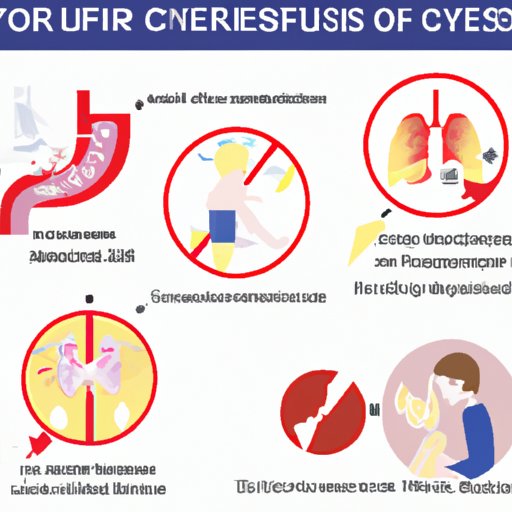
I. Introduction
Cystic fibrosis is a genetic disorder that affects the lungs and digestive system, and it affects about 30,000 people in the United States. It is caused by a mutation in the cystic fibrosis transmembrane conductance regulator (CFTR) gene, which results in the production of thick and sticky mucus that can clog the small airways in the lungs and block the ducts of the pancreas. This can lead to serious respiratory issues and digestive problems. Recognizing the symptoms of cystic fibrosis is important for early diagnosis, proper treatment, and long-term management.
II. A Comprehensive Guide to Recognizing Symptoms of Cystic Fibrosis
The symptoms of cystic fibrosis can vary from person to person, but there are some common signs to look out for. The age of onset and disease progression can also vary, with some individuals experiencing symptoms at birth and others developing symptoms later in life. It’s important to understand the different symptoms and how they can affect the body.
III. Understanding the Early Warning Signs of Cystic Fibrosis
There are some early signs of cystic fibrosis that can be easily overlooked, especially in infants and young children. These early signs include failure to thrive, which can involve poor weight gain and delayed growth, greasy stools, which can be caused by malabsorption of nutrients due to pancreatic insufficiency, and frequent respiratory infections, which can be a result of the clogged airways in the lungs. Older children and adults may experience persistent cough, shortness of breath, and decreased exercise tolerance due to the progressive nature of the disease.
IV. 5 Common Symptoms That Indicate Cystic Fibrosis
In addition to the early warning signs, there are five common symptoms that indicate cystic fibrosis. These symptoms include coughing up blood, which can be a sign of lung damage and infection, wheezing, which can indicate narrowing of the airways, chest pain, which can be a result of inflammation or infection in the lungs, decreased lung function, which can be measured through spirometry tests, and recurrent sinus infections, which can be a result of the thick mucus blocking the sinuses. If any of these symptoms are present, it’s important to seek medical attention.
V. What to Look Out for if You Suspect Cystic Fibrosis
If you suspect that you or a loved one may have cystic fibrosis, there are steps that can be taken to confirm a diagnosis. It’s important to seek medical attention if any of the symptoms of cystic fibrosis are present. Doctors can perform screening tests, such as a sweat test, which measures the amount of salt in the sweat, or genetic testing, which looks for mutations in the CFTR gene. A confirmatory diagnostic test may also be necessary, such as a chest x-ray or a CT scan, to evaluate the lungs and other organs.
VI. Cystic Fibrosis: Identifying Symptoms and Diagnosing Early
Early diagnosis of cystic fibrosis is essential for better outcomes. Current treatment options include medications, such as bronchodilators, antibiotics, and mucus-thinning drugs, as well as physical therapy and nutritional support. Some individuals may also benefit from lung transplantation or other surgical interventions. Long-term management of cystic fibrosis involves careful monitoring and ongoing treatment to prevent complications and maintain quality of life.
VII. Don’t Ignore These Physical Indicators of Cystic Fibrosis
In addition to the symptoms of cystic fibrosis, there are physical signs and indicators that can suggest the presence of the disease. These include clubbing of the fingers and toes, which is a result of chronic low oxygen levels in the blood, a barrel-shaped chest, which can be caused by hyperinflation of the lungs, and nasal polyps, which are noncancerous growths in the nasal passages. If any of these physical indicators are present, it’s important to seek medical attention right away.
VIII. Conclusion
Recognizing the symptoms of cystic fibrosis is essential for early diagnosis and proper treatment. If you suspect that you or a loved one may have cystic fibrosis, it’s important to seek medical attention right away. Current treatment options are available to manage the symptoms and improve quality of life, but early diagnosis is key to better outcomes.




